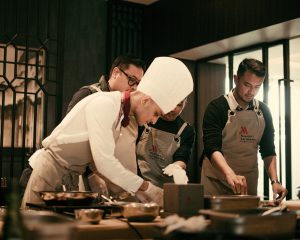Chapter 2 – Organization and Management
Pauline Milwood
“People make the place.”
—Benjamin Schneider, The People Make the Place
Learning Objectives
At the end of this chapter, students will be able to:
- Understand and apply the concept of pop-up to management planning
- Understand and apply the concept of pop-up to staffing needs, volunteers, and training
- Identify gaps and opportunities in personnel planning for pop-ups
- Create a protocol for team engagement and handling conflict for pop-ups
- Apply the concept of bootstrapping to personnel planning for pop-ups
- Create an organization structure for a pop-up restaurant.
Chapter Warm-Up
Prechapter Reading Materials
- “Building Innovation Dream Teams” in The Uncertainty Mindset: Innovation Insights from the Frontiers of Food (Tan 2020, 126–28)
- “Are You a Good Candidate to Host a Pop-Up?” (Baras 2015)
Prechapter Exercises
- Think of a time or situation where you (or someone you know) were part of a team involved in achieving a specific goal or objective but were unsuccessful in completing the goal. Describe how not achieving the goal impacted the team and what was learned from the experience.
- In teams of two, play the assigned online game using the instructions found on the web homepage.
Chapter Outline
- Management Planning for Temporary Occurrences
- Planning for and Handling Conflict in Pop-Up Teams
- Team Organization and Planning for Pop-Ups
- Gaps and Opportunities in Personnel Planning for Pop-Ups
- Organizing Pop-Up Teams
Management planning for temporary occurrences
One of the most impactful decisions for planning for a pop-up is the formation of a core management and staff team to oversee activities and decision-making related to planning, organizing, implementing, and evaluating the pop-up restaurant. In fact, labor and staffing needs for the pop-up are just as important for permanent food-service operations. The temporary nature of the pop-up as well as the variation in what appeals to customers seeking a pop-up experience will influence how plans are made for organization and management. For example, pop-ups are short term, and position needs may invariably be filled with volunteers, family members, friends, students, interns, persons seeking part-time or “gig” employment, or other forms of temporary work.
The temporary nature of the event may therefore not create opportunities for workers to establish and foster long-term service relationships with diners as traditional restaurants are able to do. This reality creates a need for teams to be organized, knowledgeable, and able to handle conflict when it does arise.
Planning for and handling conflict in pop-up teams
Conflict, whether good or bad, is bound to arise within the pop-up management team, as creative or tactical differences often exist within talented and diverse teams. Often, hospitality managers will be responsible for handling conflict among team members who may be working together for the first time. Conflict management is the application of strategies to settle opposing ideas, goals, and/or objectives in a positive manner (Walker 2021). To effectively manage conflict, hospitality managers must delicately navigate objective (facts) and subjective (emotions) realities surrounding the conflict case.

Image credit: [No title] by Josh Calabrese via Unsplash under the Unsplash license.
Walker (2021) suggests a five-step conflict management process:
- Step 1: Analyze. Managers and team members should analyze the conflict by asking:
- Who is involved?
- How did the conflict arise?
- Can a positive spin be put on the situation?
- Are there any secondary issues?
- Have positions been taken?
- Is negotiation plausible?
- Is there a way to serve all interests at hand?
- Are there external constraints/influences?
- Is there a previous history of conflict?
- Step 2: Strategize. Determine the type of strategy or approach that will be employed:
- Collaboration. Parties agree to consider the other party’s point of view, and work together to resolve the issue.
- Compromise. Parties agree to a resolution which partially addresses concerns of both parties.
- Competition. Parties could seek team input or ‘votes’ to determine how an issue should be resolved.
- Accommodation. One party agrees to give ‘space’ to the other party’s concerns at the potential detriment of their own concerns.
- Ignorance/Avoidance. As the name suggests, ignore or avoid the conflict in the hope that the situation will ‘go away’ or resolve itself.
- Step 3: Pre-negotiate. This step involves bringing together the parties to agree on the key negotiable and non-negotiable issues central to the conflict; how the conflict will be resolved; and the possible need for a conflict mediator (e.g., course instructor, manager).
- Step 4: Negotiate. This step involves discussing the issues leading to the conflict, determining a feasible set of possible solutions, and deciding to accept and commit to the solution most universally acceptable to all parties.
- Step 5: Implement and Monitor. The parties involved should actively pursue the solution agreed to. Managers should continue to monitor the situation to ensure follow through by all parties.

Team organization and planning for pop-ups
Assembling a well-rounded mix of hospitality student or hospitality manager talent is a core part of planning and a critical ingredient to the successful implementation of the pop-up restaurant. An effective team organization plan will result in a more efficient and effective planning process. Similar to traditional restaurants, pop-up managers are responsible for the basic leadership roles associated with planning, organizing, communicating, decision-making, motivating, and control.
It is generally a good principle to organize team members according to their individual strengths, skills, and abilities. For example, a student manager who is comfortable with numbers and figures may be key to budget planning and control during the development stage of the project. A student manager with significant BOH experience may be key to production management and working in the kitchen on the night of the event, while a student manager who loves interacting with guests and is comfortable resolving service concerns may be key to communicating and motivating front-of-house (FOH) team members.

Gaps and opportunities in personnel planning for pop-ups
Whatever the goal of the pop-up restaurant experience being planned, there is always the possibility of insufficient human resources to effectively plan and execute the event. Insufficient human resources can create gaps and opportunities in the planning for the pop-up event. For example, the absence of a permanent, in-house chef affords an opportunity to reach out to local chefs interested in engaging in a community-based project. Depending on the frequency or duration of the pop-up restaurant, new dishes, cuisines, and culinary talents may be featured across the same or multiple “visiting” chefs. A personnel planning gap for culinary talent also provides an opportunity for industry partnership. For example, a hospitality management degree-granting program at a public university or college might want to reach out to a neighboring hotel or restaurant to partner for the use of the hotel’s executive chef at the pop-up restaurant. These forms of public-private partnerships (PPPs) are both a great way to strengthen relationships between the industry and academia and key to gaining support from potential diners who want to support sustainable community partnerships while experiencing high-quality dining.
Due to the temporary nature of the event, the use of easily accessible and least-cost resource alternatives (e.g., volunteers, student interns) should be pursued. The term bootstrapping is an entrepreneurship-based term that describes starting up or launching a new business using existing or minimal resources. Effective bootstrapping for pop-up restaurant human resource needs is critical to overcoming some of the challenges associated with pop-up restaurants. First, the temporary nature of pop-up events means that the owner/managers will not necessarily have the ability to offer employee benefits (e.g., health insurance, vacation time) to attract workers. Second, local laws and regulations may require food safety–certified workers. Depending on prevailing unemployment trends, freelance and “gig” workers may be in great supply. It is, however, the responsibility of the pop-up management team to ensure these individuals are certified to safely handle food being served to the public. A third challenge associated with personnel gaps is the likelihood of team conflict, given that the need for short-term work may lead to volunteers, students, and interns working together for the first time.
Understanding small group dynamics and effectively managing the five stages of small group development are therefore critical to managing personnel gaps within the pop-up restaurant team. In addition, providing necessary training for FOH and BOH team members is critical to successfully implementing the pop-up event. Table 2.1 shows key positions of production (BOH) and service functions (FOH) and the supporting roles across the four phases of planning, developing, implementing, and evaluating a pop-up restaurant project.
Table 2.0 – Management functions and roles in pop-up restaurant planning
| Topic | Production (BOH) | Service (FOH) |
|---|---|---|
| Planning & Research | Budget/Financial manager
Hospitality manager
|
Researcher
Hospitality manager
|
| Development & Design | Food & beverage manager/Chef
Human resource manager
|
Dining room/Service manager
|
| Implementation | Budget/Financial manager
Food & beverage manager/Chef
Purchases manager
|
Dining room/Service manager
Reservations manager
Social media and marketing
|
| Evaluation | Budget/Financial manager
|
Dining room/Service manager
|
KEY TERMS
- Bootstrapping
- Conflict management
- Organization plan
- Personnel gaps
- Team
REVIEW Questions
- What are some of the characteristics of successful pop-up management teams?
- Discuss the pop-up concept from the perspective of Taylor, DiPietro, and So (2018). What are the key features of pop-ups that require critical management planning?
- How does planning for management and staffing needs differ between a pop-up versus traditional dining?
- What are the unique issues and challenges to personnel planning for a pop-up restaurant?
Review Activities
-
-
-
Assemble in teams of two members each. Select one strip of paper from a bowl provided by your instructor. Sitting opposite and facing your team member, open your internet browser and navigate to the game (instructor will provide URL). Read the tips and instructions provided. If your strip of paper reads “Player 1,” click “Start Player 1.” If your strip of paper reads “Player 2,” click “Start Player 2.” Each team has one hour to solve the puzzle. At the end of the session, reassemble as a class. Appoint a scribe to take a poll on which teams were successful and which teams were unsuccessful in completing the puzzle. Discuss similarities and differences between successful and unsuccessful teams.
2. Reflect on the ten-minute read “Are You a Good Candidate to Host a Pop-Up?” (Baras 2015). Share your response to this question with your team members.
-
-
Pop-up Project Task
- Using your knowledge of conflict resolution and discussions in this chapter, create a policy statement for how your pop-up management team will make decisions and handle conflict when it arises among team members.
- Design an organizational plan for your pop-up team, identifying clearly production (BOH), service (FOH), and support flows. Note: a thoughtful plan will identify personnel gaps and ways to address them (e.g., by hiring volunteers).
Resources
Chapter references
Baras, Jeremy. 2015. PopUp Republic: How to Start Your Own Successful Pop-Up Space, Shop, or Restaurant. Hoboken, NJ: Wiley. https://learning.oreilly.com/library/view/popup-republic/9781119145912/ (Penn State–authenticated link).
Schneider, Benjamin. 1987. “The People Make the Place.” Personnel Psychology 40 (3): 437–53. https://doi.org/10.1111/j.1744-6570.1987.tb00609.x.
Tan, Vaughn. 2020. The Uncertainty Mindset: Innovation Insights from the Frontiers of Food. New York: Columbia University Press. http://cup.columbia.edu/book/the-uncertainty-mindset/9780231196895 (Penn State–authenticated link).
Taylor, Scott, Jr., Robin B. DiPietro, and Kevin Kam Fung So. 2018. “Increasing Experiential Value and Relationship Quality: An Investigation of Pop-Up Dining Experiences.” International Journal of Hospitality Management 74:45–56. https://doi.org/10.1016/j.ijhm.2018.02.013 (Penn State–authenticated link).
Walker, John R. 2021. The Restaurant: From Concept to Operation. Hoboken, NJ: Wiley.
West Chester University. 2020. “Tuckman’s Stages of Group Development.” https://www.wcupa.edu/coral/tuckmanStagesGroupDelvelopment.aspx.

